NVIDIA’s GeForce GTX 480 and GTX 470: 6 Months Late, Was It Worth the Wait?
by Ryan Smith on March 26, 2010 7:00 PM EST- Posted in
- GPUs
Image Quality & AA
When it comes to image quality, the big news from NVIDIA for Fermi is what NVIDIA has done in terms of anti-aliasing of fake geometry such as billboards. For dealing with such fake geometry, Fermi has several new tricks.
The first is the ability to use coverage samples from CSAA to do additional sampling of billboards that allow Alpha To Coverage sampling to fake anti-alias the fake geometry. With the additional samples afforded by CSAA in this mode, the Fermi can generate additional transparency levels that allow the billboards to better blend in as properly anti-aliased geometry would.
The second change is a new CSAA mode: 32x. 32x is designed to go hand-in-hand with the CSAA Alpha To Coverage changes by generating an additional 8 coverage samples over 16xQ mode for a total of 32 samples and giving a total of 63 possible levels of transparency on fake geometry using Alpha To Coverage.
In practice these first two changes haven’t had the effect we were hoping for. Coming from CES we thought this would greatly improve NVIDIA’s ability to anti-alias fake geometry using cheap multisampling techniques, but apparently Age of Conan is really the only game that greatly benefits from this. The ultimate solution is for more developers of DX10+ applications to enable Alpha To Coverage so that anyone’s MSAA hardware can anti-alias their fake geometry, but we’re not there yet.
So it’s the third and final change that’s the most interesting. NVIDIA has added a new Transparency Supersampling (TrSS) mode for Fermi (ed: and GT240) that picks up where the old one left off. Their previous TrSS mode only worked on DX9 titles, which meant that users had few choices for anti-aliasing fake geometry under DX10 games. This new TrSS mode works under DX10, it’s as simple as that.
So why is this a big deal? Because a lot of DX10 games have bad aliasing of fake geometry, including some very popular ones. Under Crysis in DX10 mode for example you can’t currently anti-alias the foliage, and even brand-new games such as Battlefield: Bad Company 2 suffer from aliasing. NVIDIA’s new TrSS mode fixes all of this.

Bad Company 2 DX11 Without Transparency Supersampling
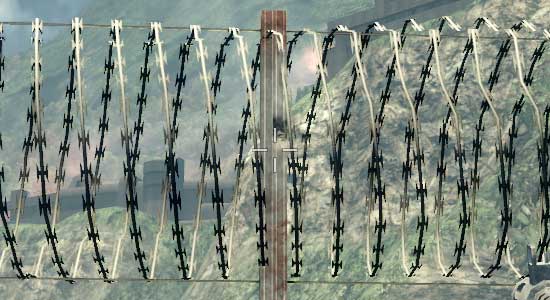
Bad Company 2 DX11 With Transparency Supersampling
The bad news is that it’s not quite complete. Oh as you’ll see in our screenshots it works, but the performance hit is severe. It’s currently super-sampling too much, resulting in massive performance drops. NVIDIA is telling us that this should be fixed next month, at which time the performance hit should be similar to that of the old TrSS mode under DX9. We’ve gone ahead and taken screenshots and benchmarks of the current implementation, but keep in mind that performance should be greatly improving next month.
So with that said, let’s look at the screenshots.

| NVIDIA GeForce GTX 480 | NVIDIA GeForce GTX 285 | ATI Radeon HD 5870 | ATI Radeon HD 4890 |
| 0x | 0x | 0x | 0x |
| 2x | 2x | 2x | 2x |
| 4x | 4x | 4x | 4x |
| 8xQ | 8xQ | 8x | 8x |
| 16xQ | 16xQ | DX9: 4x | DX9: 4x |
| 32x | DX9: 4x | DX9: 4x + AAA | DX9: 4x + AAA |
| 4x + TrSS 4x | DX9: 4x + TrSS | DX9: 4x + SSAA | |
| DX9: 4x | |||
| DX9: 4x + TrSS |
With the exception of NVIDIA’s new TrSS mode, very little has changed. Under DX10 all of the cards produce a very similar image. Furthermore once you reach 4x MSAA, each card producing a near-perfect image. NVIDIA’s new TrSS mode is the only standout for DX10.
We’ve also include a few DX9 shots, although we are in the process of moving away from DX9. This allows us to showcase NVIDIA’s old TrSS mode, along with AMD’s Adapative AA and Super-Sample AA modes. Note how both TrSS and AAA do a solid job of anti-aliasing the foliage, which makes it all the more a shame that they haven’t been available under DX10.
When it comes to performance, keep in mind that both AMD and NVIDIA have been trying to improve their 8x MSAA performance. When we reviewed the Radeon 5870 back in September we found that AMD’s 8x MSAA performance was virtually unchanged, and 6 months later that still holds true. The performance hit moving from 4x MSAA to 8x MSAA on both Radeon cards is roughly 13%. NVIDIA on the other hand took a stiffer penalty under DX10 for the GTX 285, where there it fell by 25%. But now with NVIDIA’s 8x MSAA performance improvements for Fermi, that gap has been closed. The performance penalty for moving to 8x MSAA over 4x MSAA is only 12%, putting it right up there with the Radeon cards in this respect. With the GTX 480, NVIDIA can now do 8x MSAA for as cheap as AMD has been able to
Meanwhile we can see the significant performance hit on the GTX 480 for enabling the new TrSS mode under DX10. If NVIDIA really can improve the performance of this mode to near-DX9 levels, then they are going to have a very interesting AA option on their hands.
Last but not least, there’s anisotropic filtering quality. With the Radeon 5870 we saw AMD implement true angle-independent AF and we’ve been wondering whether we would see this from NVIDIA. The answer is no: NVIDIA’s AF quality remains unchanged from the GTX200 series. In this case that’s not necessarily a bad thing; NVIDIA already had great AF even if it was angle-dependant. More to the point, we have yet to find a game where the difference between AMD and NVIDIA’s AF modes have been noticeable; so technically AMD’s AF modes are better, but it’s not enough that it makes a practical difference
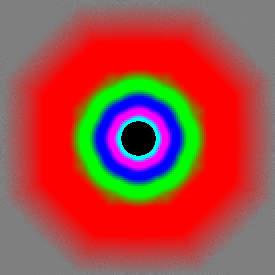
GeForce GTX 480

GeForce GTX 285
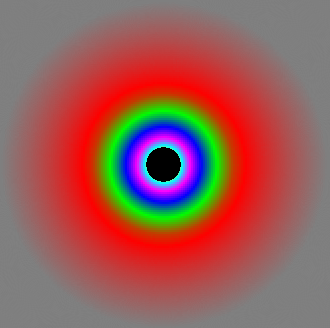
Radeon 5870


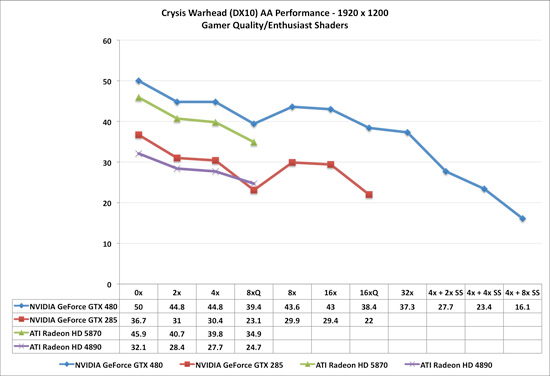
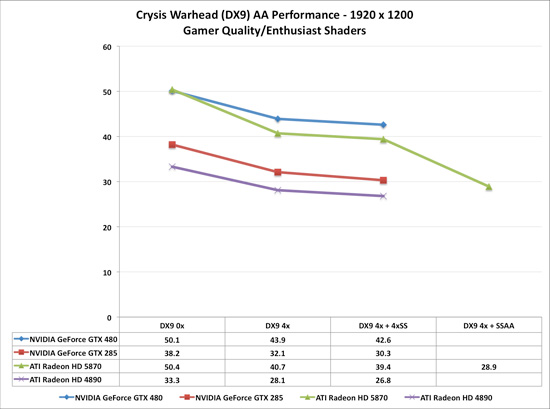








196 Comments
View All Comments
Sunburn74 - Sunday, March 28, 2010 - link
It is absolutely ridiculous. Like having a buzzsaw in your case.http://www.hardocp.com/article/2010/03/26/nvidia_f...">http://www.hardocp.com/article/2010/03/26/nvidia_f...
Belard - Sunday, March 28, 2010 - link
AMD already stated they are not reducing their pricing any time soon. This is because their line-up is far healthier than Nvidia.They know (and we should know) that the $500/$350 price for the new GeForce 4 cards are not going to stick. There is only some many thousands of cards available for the next 3~5 months. The supply will run dry in about 1-3 weeks I bet. We're going to see the pricing shoot up close to $600 for the GF480, the fanboyz will be willing to pay that price.
The 5850 was supposed to be a $250 card, we see how well that worked out. While the price did settle around $300, the 5850 was still a better value than the $370~400 GeForce 285 card as it was far faster and run cooler, etc. The 5870 is typically faster than the $500 GeForce 295 - for $100 less. ATI has no reason to lower their pricing.
The GeForce 265~295 cards are already being phased out, too slow, cost too much.
So nVidia has nothing for the sub $300 market... nothing. Only the GF-250 has any value but a tad expensive as it should be $100 since its still a DX10 re-badged 9800GTX.
So when ATI feels any pressure from Nvidia, they can easily drop their prices. It costs $5000 per wafer, no matter how many chip dies are on it. It may be costing nVidia $150~200 per chip while for AMD, they could be paying $20~35 per chip used in the 5800/5900s.
Then you add the costs for memory, the PCB, parts, cooling system etc.
It is very easy for AMD to drop $50 per GPU and they'd still make a profit while Nvidia sells their geForce 400 cards at a loss or no profit.
When ATI sells the 5830 for $190~200, 5850 at $250 and 5870 at $325~350 would help sales and keep nVidia at bay.
We'll see...
SirKronan - Sunday, March 28, 2010 - link
I would've liked to see 5850's in crossfire thrown into this mix. I know you don't have time to test them all, but I think that's the key competitor against the 480 when it comes to bang/buck. I would think the 5850's in crossfire could handily beat the 295 and the 480, all while consuming less power. I believe there may have been another site that did it, but with this excellent and very thorough review done here, it would've been even that little tiniest bit sweeter to have a 5850 crossfire line on their graphs.Regardless, thanks for the informative review!
B3an - Saturday, March 27, 2010 - link
This review and any other pages on this site are not working in Firefox... they have been reported as attack pages."This web page at www.anandtech.com has been reported as an attack page and has been blocked based on your security preferences."
This is why FF with all default settings, and just using adlock.
Could it be trouble with the ads again using a malware/virus?
Ryan Smith - Sunday, March 28, 2010 - link
We know. It's being worked on.Sunburn74 - Saturday, March 27, 2010 - link
The 5850 idles inthe mid 30's but it also does absolutely nothing to stay cool, operating at about 20% max fan speed. Under load it may go up to 30% fan speed, but rarely ever breaks the 40% mark.What are the approximate idle and load fan speeds for both the gtx 480 and 470? I guess I'm asking this to understand just how much extra cooling room is innately available. Are these card working at max capacity to keep cool or is there thermal/fan headroom there to be had?
Ryan Smith - Saturday, March 27, 2010 - link
I don't have that data on-hand (we don't record fan speeds), but it's something that I should be able to easily grab at a later time.Lemonjellow - Saturday, March 27, 2010 - link
For some reason Chrome is flagging this article as a malicious sight... Oddness... Possibly got a bad advertisement...NJoy - Saturday, March 27, 2010 - link
well, Charlie was semi-accurate, but quite right =))What a hot chick... I mean, literately hot. Way too hotWiNandLeGeNd - Saturday, March 27, 2010 - link
Looking back at the data, I realized that power consumption is for system total. Guru3d measured the power consumption of the card itself and reported a max of 263W, so roughly 21 A. I think my 850W will do just fine since each PCI-X con has 20A each.